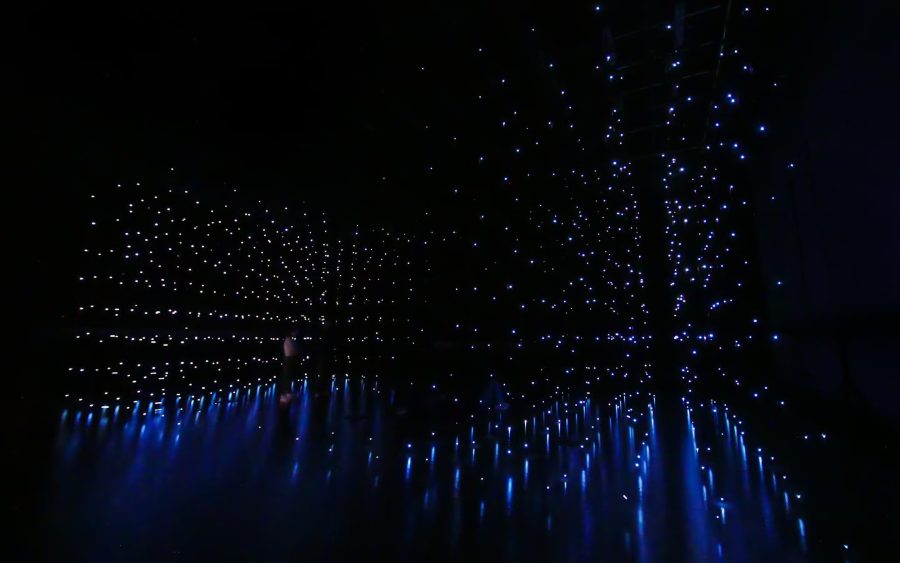N O W I S W H E N W E A R E (the stars) was an immersive gallery experience held in the Weitz Theater from September 8 to September 18. This new, one-of-a-kind exhibition swept visitors on a journey from complete darkness to total immersion into a galaxy of lights. It “invite[d] viewers to become active explorers… as they discover[ed] the traces of themselves in light, the universe, and those who have been here before us.” Each visitor was guided by an unseen narrator through their individual journey through the exhibit. The installation contained 384 sound systems and nearly 5,000 individual reactive points of light that hung from the ceiling.
Andrew Schneider is the artist behind the stars, in collaboration with the Los Angeles Performance Practice, a platform for touring dance and theater. A creator of interactive electronic work, Schneider is a nationally renowned artist, an OBIE award winner and a Drama Desk Theater Award nominee. He is interested in not only the technical aspect of his productions, but also the empathy that his assortment of speakers and string lights can teach us. “If theater at its core is humans telling stories about ourselves to each other, then I hope it is in the service of getting better at being human,” he states on his website. “This is why I make the work that I make.”
This experience started with a conversation. Schneider asked visitors, “Where is home to you?” Many said “Northfield,” others “California,” and some, “Musser.” He nodded without comment before leading the visitors into the space.
Visitors to N O W I S W H E N W E A R E (the stars) entered a completely dark and silent room, devoid of any stimulation from the outside world. Reflecting on the sensory deprivation, one visitor remarked, “I had the ability to be completely present in the now… to surrender to the artistic act.”
After a few minutes of staring into the silent, black abyss, a small star-like light appeared from the shadows. It flickered to the rise and fall of Schneider’s voice, as if he were talking to the audience through the star, narrating throughout the exhibition. The intricate speaker system evoked the feeling of him whispering in your ear one moment and talking across the room the next.
Faint music accompanied Schneider’s narration as he invited visitors to move around the space. As they explored the exhibit, they discovered that the stars lit up when touched and faded away in the absence of movement. Each audience member was enveloped by a cocoon of stars. As they explored this new world, they found that each point of light seemed to be whispering a story. The audio became more distinct until visitors were able to listen to one story at a time.
The exhibit allowed visitors to hear the stories of thousands of individuals interviewed for Scheider’s project: a mundane memory of taking a walk, an introspection about the meaning of home and how it relates to family, a tearful account of a dearly loved mother who had since passed away. Dr. Andrew Carlson ’99, a Carleton theater professor, commented, “The many different lights and stories at the end [of the exhibit] remind me of the ways in which there are so many different stories we hear and are lost. There is no possible way to hear every story. Do we seek every voice that we can, or really focus on one and listen carefully?”
Dr. Carlson assigned his students to visit the exhibit for his A&I seminar “The Power of Story.” It is therefore fitting that Schneider stated his drive to make art stems from his belief that stories make us better human beings: one of the primary themes of Dr. Carlson’s class is catharsis through storytelling. The premise is that sharing another human being’s experience vicariously through storytelling allows a sort of emotional purge to take place. “I carried a lot of grief with me into the room,” Dr. Carlson said, “and it felt very charged and emotional for me [when the narrator asked me to think about it].”
Dr. Carlson said he assigned the exhibit so students would have the opportunity to experience stories outside of the traditional plot-driven storytelling style. Students also drew connections with works from the course. “In The Poetics, Aristotle writes of his disdain for episodic storytelling, which is exactly what [the stars] was,” noted Sam Ullman ’26. “He would have really hated this production.”
At the end of the exhibit, visitors were led into a dimly lit room to allow their eyes to adjust after the darkness. There, they were given the opportunity to reflect on the experience and tell their own story using a microphone. Each recording will be incorporated into the stars along with hundreds of others. The exhibit was a changed world after visitors left: they each carried memories of the experience with them in addition to contributing their own story. The Stars exhibit was the kind that doesn’t leave you as soon as your allotted time is done. It was a unique artistic experience that continued far beyond its conclusion.












